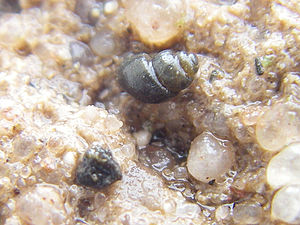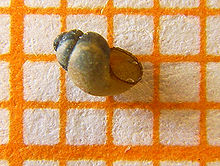Rhön spring snail
| Rhön spring snail | ||||||||||||
|---|---|---|---|---|---|---|---|---|---|---|---|---|

Rhön spring snail ( Bythinella compressa ) |
||||||||||||
| Systematics | ||||||||||||
|
||||||||||||
| Scientific name | ||||||||||||
| Bythinella compressa | ||||||||||||
| ( Frauenfeld , 1857) |
The endemic Rhön spring snail ( Bythinella compressa ), also Rhön spring snail called, comes only in the world Rhon and Vogelsberg ago. It is still proven in the natural forest reserves of the Rhön and is severely endangered according to the Red List BRD .
features
The shell of the Rhön spring snail is egg-shaped with a truncated cone. It is only about 2.0 to 2.3 mm high and 1.4 to 1.8 mm wide. It has 3 to 4 strongly arched and rapidly increasing turns with a deeply sunk seam. The penultimate turn is narrower than the last turn. The last turn takes up about half of the total height. The apex is slightly and the umbilical crevice is open. The obliquely egg-shaped, slightly angular mouth is almost vertical and is slightly inclined back. It can be closed with an operculum. The shell of the Rhön spring snail is yellowish gray and translucent. The edge of the mouth stands out somewhat due to the dark brown color. The outer wall of the mouth is usually straight, sometimes even slightly indented. The edge of the mouth is fully developed and only slightly expanded on the spindle side.
Similar species
The shell is similar to the shell of Dunker's spring snail ( Bythinella dunkeri ). The latter type, however, is significantly taller and somewhat slimmer. The mouth is slightly more angular than that of the Rhön spring snail.
Geographical distribution and habitat
The Rhön spring snail occurs only in the Rhön and the Vogelsberg region (Hesse).
The Rhön spring snail needs evenly cold and unpolluted, low-lime water ( saprobi value 1.0) at approx. 6–8 ° C. It feeds on growth, mainly bacterial lawn, and detritus that is grazed by stones, water plants, fallen leaves and dead wood lying in the water .
It used to be widespread in the open cultural landscape. Today it lives almost exclusively in spring outlets and a few hundred meters down in the spring streams of contiguous deciduous forest areas. In intact habitats there are population densities of up to 50 snails on an area of 25 x 25 cm.
Loss of habitat and causes of danger
The populations of the Rhön spring snail are largely isolated from one another. With their highly specific habitat requirements, extinct occurrences are therefore irretrievably lost; as a rule, former habitats are not repopulated. The uncontaminated and near-natural source areas in the Rhön and Vogelsberg, the habitat of the Rhön spring snail, are mainly endangered by intensive agriculture and municipal construction measures.
The cause of the sharp decline in stocks is generally the destruction of the source biotopes. In agriculture these are, for example, the use of fertilizers and pesticides and the establishment of cattle watering systems (step, eutrophication ). Also new trout ponds in source areas with the often associated piping of the source streams and the creation of spruce monocultures with the consequence of acidification of the soils and springs.
Hazards from municipal measures are, for example:
- Spring sources to create tourist attractions.
- New roads in forest areas with the resulting pollution from de-icing salts, oils and abrasion ( fine dust ).
- Drainage and rock extraction in the catchment area as reasons for the springs to dry out.
Protective measures
Settled headwaters should be inventoried and protected. The consequences of this are:
- The opening of pipelines and the dismantling of ponds and spring catchments
- Protection should be taken into account when planning, building and maintaining forest roads.
- The replacement of coniferous trees with typical wet forest stands (e.g. black alder and common ash ).
supporting documents
literature
- Peter Glöer: The animal world of Germany. Mollusca I Freshwater gastropods of Northern and Central Europe Key to identification, way of life, distribution. 2., rework. Edition. 327 pp., ConchBooks, Hackenheim 2002, ISBN 3-925919-60-0 .
- Christian Strätz, Klaus Kittel: The distribution of the Rhön spring snail Bythinella compressa (Frauenfeld 1857) in northern Bavaria. In: Communications from the German Malacoological Society. Volume 84, Frankfurt a. M., January 2011, pp. 1-10 ( PDF file ).
On-line
Web links
- Thuringian State Agency for the Environment (nature and landscape / species aid programs)
- 1995–2002 Bavarian State Institute for Forests and Forestry, 2001 Document: LWF - certified - Information from science / from LWF-aktuell No. 29
- Bythinella compressa inthe IUCN Red List of Threatened Species 2013.2. Posted by: Falkner, G. & Seddon, MB, 2011. Retrieved February 15, 2014.

